The most important knife skill for survival in the wilderness
What knife skill is essential? Is it just carving, or is it an all-encompassing ability that allows you to survive in emergency situations?
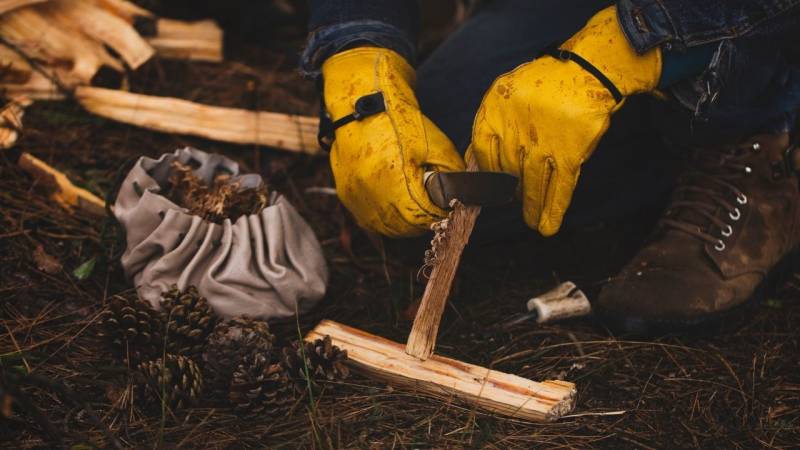

From Martin Gebhardt. Check out my “About me” page.
👉 The key facts from this guide
- A knife is a versatile tool that can be used for a variety of tasks in the wilderness, including making objects, chopping wood, and starting a fire.
- Handling a knife safely is of the utmost importance. Some basic safety tips are to cut away from yourself, work within the "death triangle," and make sure the knife is always sharp.
- The most important skill one can have with a knife is starting a fire. Fire is essential in the wilderness as it can be used for boiling water, preparing food, protecting oneself from animals, providing light, and drying wet clothing.
- There are different methods of starting a fire with a knife, including carving Feathersticks, creating fine wood shavings with the spine of the knife, and chopping wood through Batoning.
- A knife made of carbon-rich steel can also be used to create sparks and start a fire.
Over time, humans have invented many simple machines that have had a massive impact on their lives.
One of these inventions is the wedge.
Sounds rather simple and boring, right?
But wait: You may change your mind about the humble wedge soon.
A wedge is a sloping surface with two side faces that meet at a sharp angle.
And this sharp angle is sharp enough to cut and separate things. Things like wood, meat, and even metal.
Does that sound familiar? A knife is actually a wedge. Hence, my love affair with this simple machine.
A Knife Is Your Most Versatile Tool
It's not just the aesthetics of the forged metal that catches my attention.
The knife is perhaps the most useful tool a person can carry in a pocket or on their belt.
And why?
Knives are meant to do more than just spread butter on bread.
In skilled hands, you can use it to create things. EXTREMELY IMPORTANT survival things.
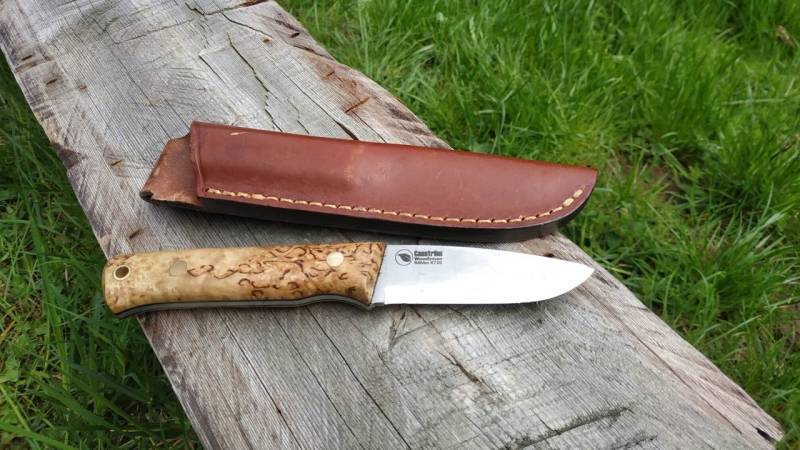
Acquiring various knife skills is the best way to replace all the wonderful items in your survival kit.
Safe and skillful use of a sharp knife has always been a top priority for lumberjacks, forest women, trappers, and scouts throughout history.
Before we dive into the skills, let's start with how to handle a knife safely.
Knife Safety
The fact is: A sharp knife is a safe knife.
Dull knives require more force to cut and increase the risk of injury. So make sure your knife is razor sharp.

In my guide "Why is a sharp knife safer than a dull knife?" I go into more detail on the subject.
Below are some tips on basic knife safety for outdoor self-sufficiency:
- Cut away from your body. This is good advice for beginners and advanced users. However, there are also methods for carving wood towards your body. I show more than 10 safe carving techniques in my Wildimpuls program (in German).
- Use your knife outside the death triangle (an imaginary triangle between your knees and crotch).
- Always check if other people are in the danger zone (a circle that you make with your outstretched arms as you turn 360 degrees).
- Always work standing firmly or sitting down.
- Cut with your knife, do not push.
- Always pack your knife away safely after use.
Reading tip: Also read my guide "This simple and inexpensive trick will show you how to keep your knife sharp".
The most important knife skill: Creating fire
Regardless of the season or environment, a solid outdoor knife sits at my hip.
If I'm ever separated from my backpack, my knife is still on my person.
In this case, it is now my only tool option. A good fixed blade knife is your most important tool in the wilderness.
Why such a bold statement?
One word… fire!
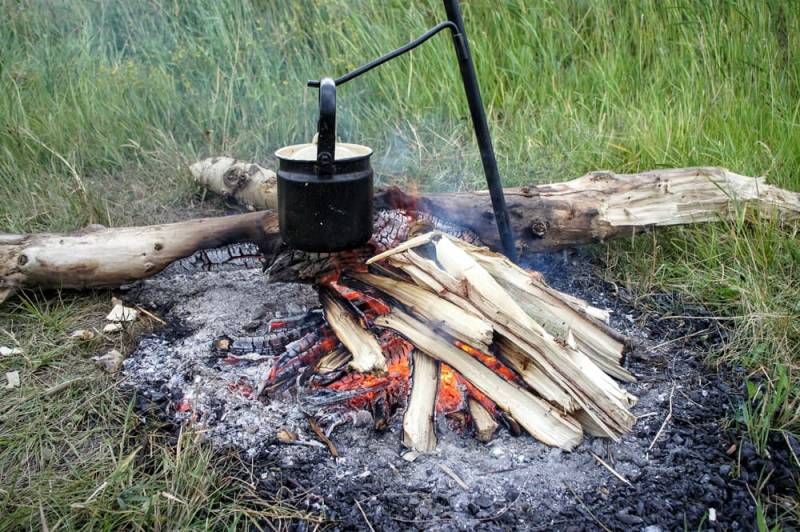
Fire covers a variety of survival methods.
- Boiling water
- Cooking food
- Protection from animals
- Light in the dark
- Drying wet clothes
- Production of raw materials (coal, ash)
This sharp metal wedge on your hip is probably your only hope for fire.
Campfires are certainly captivating. But we build them for so much more than just staring into the flickering flames.
Fire is your best sleeping pill. And sleep is the most overlooked skill in the outdoors.
"The quality of a survival kit is determined by how much it can help you when you need to sleep. If you can sleep well at night, you have it made."
- Mors Kochanski
Translated, that means: "The quality of a survival kit is determined by how much it can help you when you need to sleep. If you can sleep well at night, you have it made."
In this case, it would be smart to have a knife that is capable of providing enough tinder and kindling for a fire (What's actually the difference between tinder and kindling?).
Here in the German forests, there is a lot of small kindling material without ever having to take my knife out of its sheath.
However, when it comes to tinder, a knife significantly accelerates the process.
Also read: Sleeping outside in winter – with these tried and tested tips it's certain to work
Processing wood
No fuel, no fire. Let's take a look at the fantastic possibilities of wood processing that lead us to fire.
Carving Feathersticks
Making Feathersticks (wood shavings) is one of the basics in bushcraft and survival, and is an excellent skill to practice.
Pretty little shavings that are bundled at the end of a stick are created by controlled cuts. The thin surface of the Feathersticks makes them easily combustible.
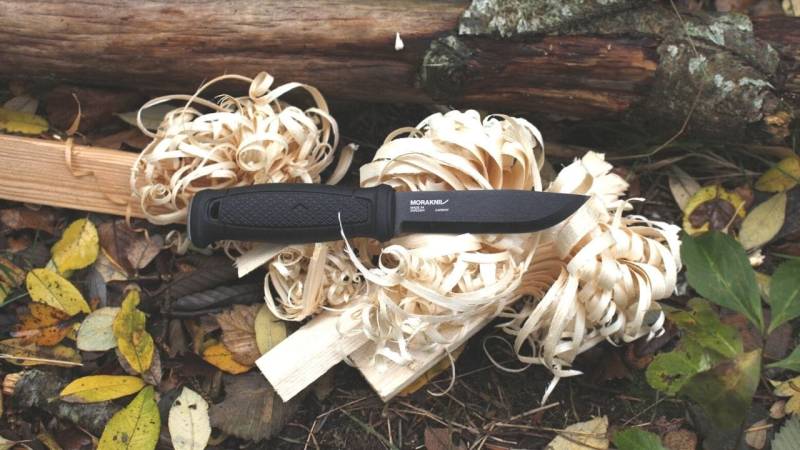
Find out more about these incredible wood shavings in my article "What are Feathersticks? (with video)".
And there's an even easier way to quickly make Feathersticks. All you need is a paring knife / spoon knife.
If you own such a paring knife, then use it the next time to quickly make your kindling.
Here's a video on the process:
Feather sticks are pretty and useful, but sometimes too coarse. Let's make finer wood shavings instead.
Making Fine Wood Shavings Using the Blunt Edge of Your Knife
To create even finer material with your knife, use the blunt edge of your knife.
But be careful, this technique only works if the blunt edge of your knife is sharp. Unfortunately, this does not work with the inexpensive Morakniv Companion (review here).
You need to use the Mora Eldris, the Mora Garberg, or a high-priced Casström knife to do this.
The advantage over feather sticks is also that you require less skill with the knife than with feather sticks. Even beginners can quickly learn this technique.
So, use the blunt edge of your knife to scrape off the wood and make a bundle of fine and coarse tinder material.
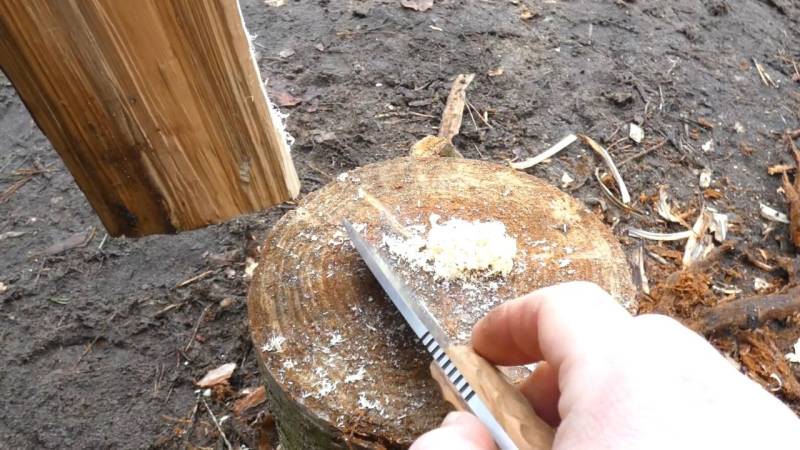
My absolute favorite, however, is a pine resin torch.
Pine Resin Burns Extremely Well
Many conifers contain a lot of resin. Resin burns and is a perfect accelerant.
In pine trees, resin accumulates in branch sockets and roots – particularly in felled and dead trees over the course of years.
The result: pine shavings – wood chips that are saturated with resin. The shavings from pine wood are one of the best natural kindling (read all about pine shavings here).
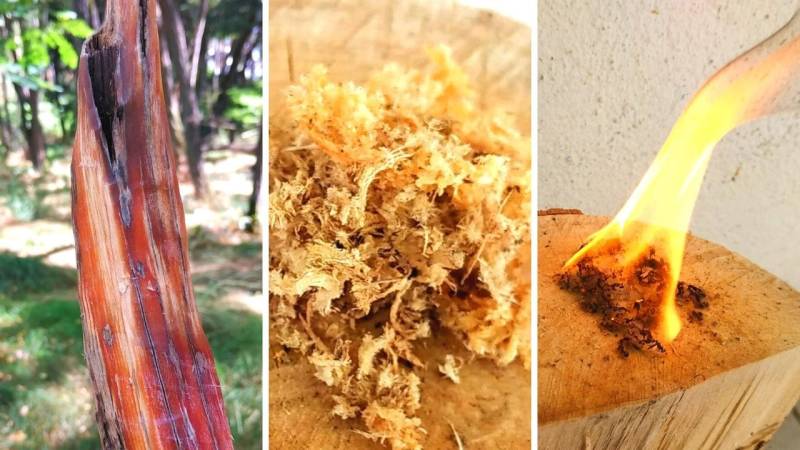
To get the pine wood shavings burning, you scrape the fine curls off at a rectangular angle to the wood chip with the back or blade of a knife.
Then shoot a spark into the shavings with a fire steel and the resin curls will start to burn.
Read about how to use a fire steel exactly in the article How to quickly and easily start a fire with a fire steel (instruction + video).
Batoning – splitting wood
Without an axe, you can easily create firewood using a solid knife and the splitting stick method (batoning).
Yes, I know, batoning is frowned upon by many in the outdoor community. But what's better? Being without firewood or having a Plan B up your sleeve?
A full-tang knife with a sturdy 10 cm long blade is sufficient to produce tinder, kindling (pencil-thick sticks), and firewood from a single piece of wood.
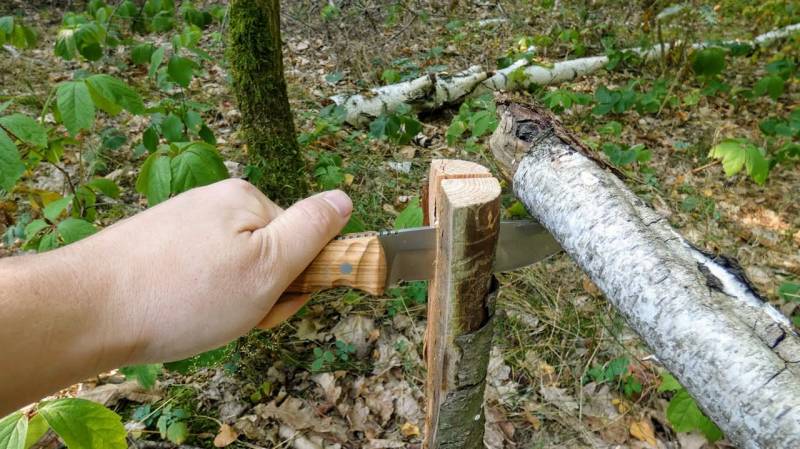
Creating a Bow Drill
Without a knife, you won't be able to create a bow drill. Even making the hearth board of a hand drill will be difficult without a knife.
You need a spindle, a hearth board, a bow, and a bearing block for the bow drill. With the right knife skills, you can easily carve all of these things in a short time.
The result: You can start a fire - using only wood, cord, and your knife.
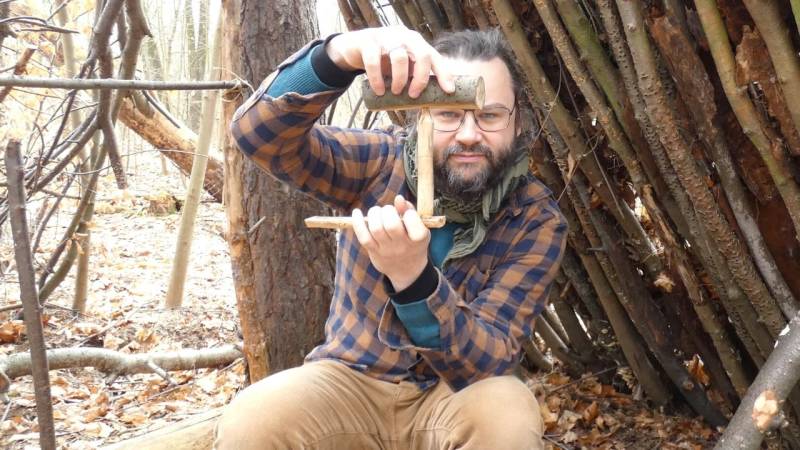
If you are interested in the primal method of igniting a fire, be sure to check out my annual program Wildimpuls. I am convinced that everyone can learn this method with my tips and technique.
Knife and Sparks
If you are the lucky owner of a knife made of carbon-rich steel, you can ignite a fire. The steel in your knife is another fire resource.
The idea of hitting the back of your expensive knife with a sharp piece of stone to generate sparks is probably a horror for knife junkies.
But it doesn't matter. Your blade can save your life. You don't have to practice it every week, but knowledge about it is already invaluable. The same goes for all tools made of carbon-rich steel, like files, for example.
How to create sparks with a file exactly, I will show you in the video here:
Always remember: Fire means life. How much is your life worth to you? I would say, much more than an expensive knife.
Your knife is an indispensable tool for making fire.
To strengthen your skills in handling the knife, I have more guides for you.
- 5 Knife skills that you need to master for bushcrafting
- 9 Tricks for sharpening a knife without a sharpening stone
And if you are not sure which knife to choose, be sure to check out my ultimate buying guide "The best bushcraft knife - your ultimate buying guide".
And now off to the woods. Enjoy the knowledge.


Author of the guide
Martin Gebhardt
Hey, I'm Martin. On my blog, you will learn the basics and numerous details about living in the wild. I think survival, bushcraft and the good life in nature are the keys to happiness. Find me here on Instagram or on YouTube. You can find more about my mission on the About Me page.
Was this guide helpful?
20 people found this guide helpful.
5.00 out of 5 points (20 Ratings)
Comments (0)
This post may contain affiliate links. So if you click on the links and make a purchase, I will receive a small commission at no additional cost to you. Click here, to learn more about it.



